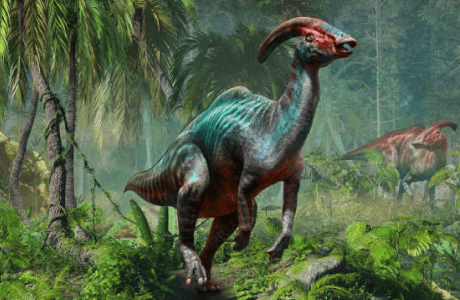Parasaurolophus

A herd of dinosaurs with fancy crests on their heads graze along a shoreline in what’s now western North America about 75 million years ago. Suddenly, one of the animals—called a Parasaurolophus—stands up on its two hind feet, lifts its head, and takes a big gulp of air. Then it releases a honking alarm call that sounds sort of like an elephant trumpeting. The other Parasaurolophus dinosaurs understand the message—a predator is nearby.
Scientists made the discovery by examining the tubelike holes inside the crest. One paleontologist created a replica using plastic pipes he could blow into—and out came a trumpetlike B-flat note. Scientists still aren’t sure if Parasaurolophus used its sounds for defense, attracting mates, communicating with the herd, or all of these.
Music maker
This dino grew to be about 33 feet from snout to tail, and its crested skull was over five feet long. That curved, bony crest puzzled scientists in the past: Some thought it might be a super sniffer, or something like a snorkel to breathe while underwater. Turns out, the crest was a noisemaker.
This dinosaur had flight feathers on both its front and back limbs, and it had long upper arm bones similar to those seen in today’s birds. It also had a fan of feathers on its tail that it might have used to steer as it coasted to the ground. Scientists have discovered that its feathers were iridescent, meaning they had a metallic shine similar to the feathers of modern peacocks and hummingbirds.
Not-quite-right name
This dino’s name means “like Saurolophus,” which is another crested dinosaur. (Saurolophus means “lizard crest.”) But it turns out these two aren’t that similar: Saurolophus’s headgear was solid; Parasaurolophus’s crest was hollow. So experts believe they used them for different reasons.
However, both animals are part of a group of herbivorous (or plant-eating) dinosaurs called duckbills because of the flat shape of their mouth bones. But that’s also not exactly right: These animals had shovel-shaped beaks—not bills—for snipping off pieces of tough plants like evergreens and ferns. They also had teeth in their cheeks chewing and grinding the plant matter.
